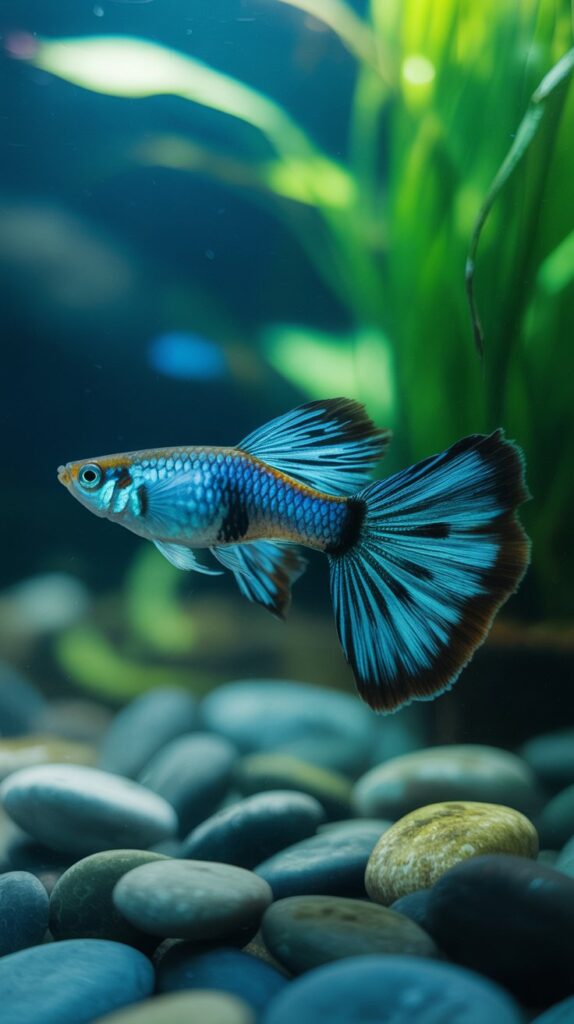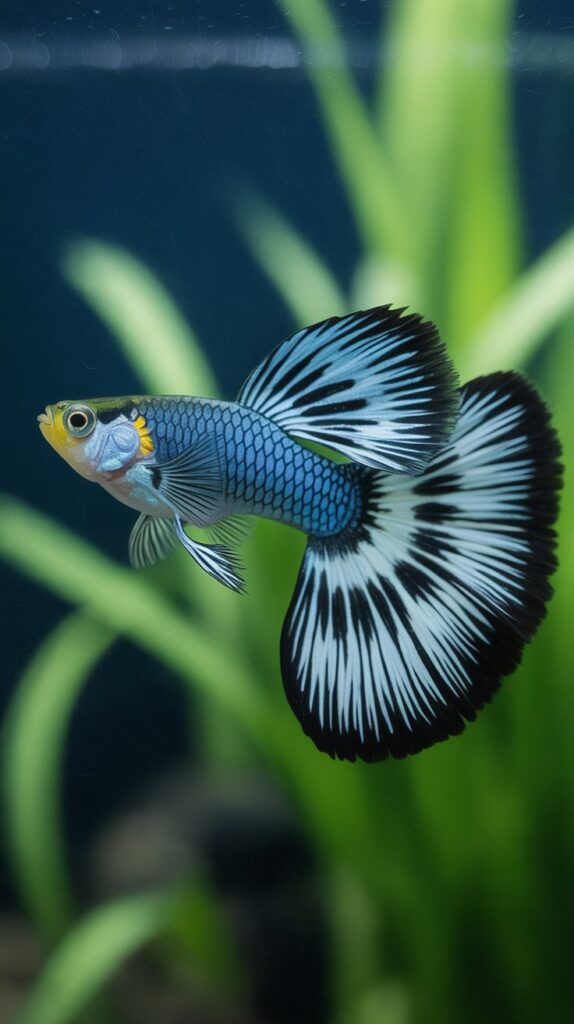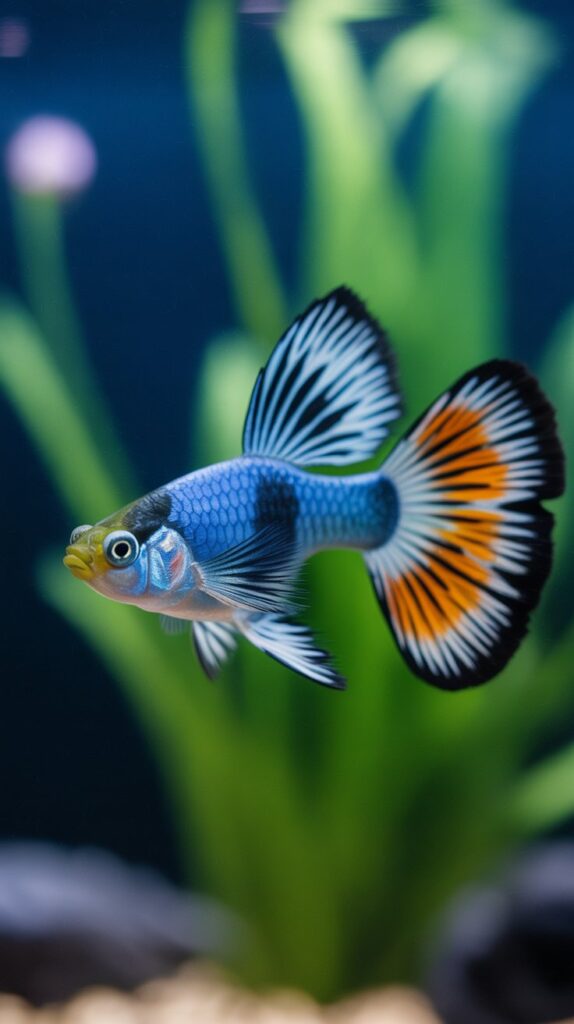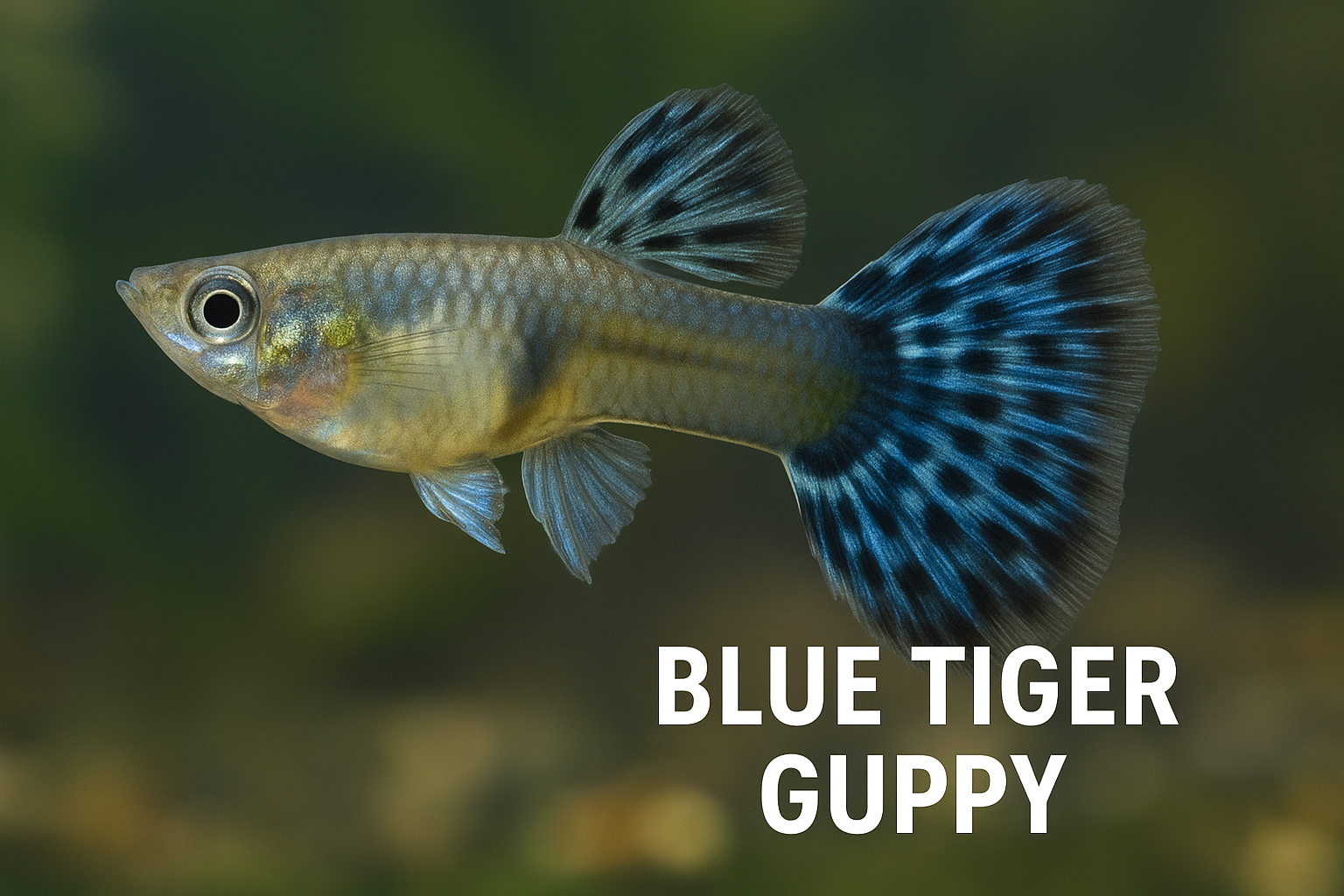The Blue Tiger Guppy is one of the most eye-catching guppy varieties in the aquarium hobby. With its striking blue coloration and fierce black tiger-like stripes, it brings elegance, contrast, and energy to any freshwater tank. These guppies are a product of selective breeding, blending the beauty of the tiger stripe pattern with dazzling blue tones that shimmer under aquarium lighting.
Whether you’re a beginner looking for a hardy, colorful fish or an experienced aquarist seeking a unique strain for breeding, the Blue Tiger Guppy is an ideal choice. This in-depth care guide covers everything you need to know—from origins and appearance to tank setup, breeding, and FAQs.
1. Introduction to Blue Tiger Guppy
The Blue Tiger Guppy is a designer guppy strain developed for its vibrant blue coloration and wild, tiger-like black stripes. The result is a guppy that resembles a small, living artwork—its tail and fins rippling with electric blues and contrasting black patterns.

These guppies are favored by hobbyists for more than just their looks. They’re hardy, adaptable, easy to breed, and make excellent members of peaceful community tanks. Their energetic swimming behavior and social nature also make them fun to watch.
2. Origin and Background
Guppies (Poecilia reticulata) originate from the warm, freshwater streams of South America. Over decades, selective breeding across the globe has produced hundreds of stunning varieties—including the Blue Tiger Guppy.
This particular strain emerged as a result of crossbreeding blue-bodied guppies with those exhibiting tiger tail patterns (dense black stripes on the tail). Breeders aimed to create a fish that combines vivid color with wild markings—and they succeeded spectacularly.
Today, Blue Tiger Guppies are bred widely in Southeast Asia and Europe and are popular exports in the ornamental fish trade.
3. Physical Characteristics

Blue Tiger Guppies stand out due to their vivid colors and exotic patterns. Their unique appearance makes them highly desirable among collectors and aquascaping enthusiasts.
Notable Traits:
- Body Color: Metallic or electric blue
- Tail Pattern: Black tiger-like stripes over a blue or translucent background
- Tail Shape: Fan tail, delta tail (most common)
- Fin Color: Matching blue with black stripes
- Size:
- Males: 1.2 – 1.5 inches
- Females: 2.0 – 2.4 inches
The sharp contrast between the black and blue makes their tails look like flickering flames in the water.
4. Male vs Female Blue Tiger Guppies
It’s easy to distinguish between the sexes, especially when you’re trying to set up a breeding group or manage population control.
| Trait | Male | Female |
|---|---|---|
| Color Intensity | Bright blue with defined tiger stripes | Lighter, duller coloration |
| Size | Smaller and more slender | Larger, more rounded body |
| Fins | Large, colorful, flowy | Smaller and more functional |
| Gravid Spot | Absent | Visible dark spot near anal fin |
| Behavior | Active, chases females | Calmer, slower-moving |
Males are generally more attractive in display tanks, while females are essential for breeding.
5. Behavior and Temperament
Blue Tiger Guppies are peaceful, lively, and social. They are best kept in small groups and can easily be part of a multi-species tank.
Behavioral Traits:
- Active swimmers, often seen darting or hovering mid-water
- Males may chase females during mating displays
- Non-aggressive and peaceful
- Get along well in community tanks
Keeping at least 5–6 guppies in a group is ideal for reducing stress and encouraging natural behavior.
6. Ideal Tank Setup

Creating the right environment will help your Blue Tiger Guppies thrive and show off their full potential.
Tank Requirements:
- Minimum Size: 10 gallons for a small group
- Substrate: Fine gravel or sand
- Plants: Java moss, hornwort, guppy grass (for shelter and fry protection)
- Lighting: Bright LED lights to enhance blue coloration
- Filtration: Sponge filter or low-flow filter system
- Decor: Rocks, driftwood, and floating plants
These guppies do best in a well-decorated tank with plenty of hiding spots and open swimming space.
7. Water Parameters
Maintaining ideal water conditions is key to ensuring the health and longevity of your Blue Tiger Guppies.
- Temperature: 74 – 82°F (23 – 28°C)
- pH: 6.8 – 7.8
- Hardness: 8 – 12 dGH
- Ammonia/Nitrite: 0 ppm
- Nitrate: Below 20 ppm
Perform 20–30% water changes weekly and use a reliable water testing kit to keep conditions optimal.
8. Feeding and Nutrition
Blue Tiger Guppies are omnivores and require a balanced diet to enhance their color and maintain energy.
Recommended Diet:
- Staple: High-quality guppy flakes or micro pellets
- Live/Frozen: Brine shrimp, daphnia, mosquito larvae
- Vegetable Matter: Spirulina flakes, blanched spinach, algae wafers
- Color Enhancers: Foods rich in carotenoids and astaxanthin
Feed 2–3 small meals per day, and avoid overfeeding to maintain water quality.
9. Compatible Tank Mates

Blue Tiger Guppies are peaceful and best housed with other non-aggressive fish.
Good Tank Mates:
- Neon Tetras
- Mollies
- Platies
- Endler’s Livebearers
- Corydoras Catfish
- Cherry Shrimp
- Nerite Snails
Avoid:
- Aggressive species (e.g., Bettas, Barbs)
- Fin-nippers
- Large, carnivorous fish
10. Breeding the Blue Tiger Guppy
Breeding guppies is simple—even accidental! The Blue Tiger Guppy is a prolific breeder when housed in mixed-gender groups.
Breeding Tips:
- Use a 1 male to 2–3 female ratio
- Provide dense plants or a breeding box
- Keep water warm (78°F) to stimulate breeding
- Offer protein-rich food to condition breeders
Gestation:
- 21–30 days
- Each female can give birth to 20–60 fry
11. Fry Care and Growth
Fry are small and defenseless when born and can be eaten by adults if not protected.
Tips for Raising Fry:
- Transfer to a separate nursery tank or use a breeding trap
- Feed baby brine shrimp, infusoria, and crushed flakes
- Maintain warm, clean water with low flow
- Offer cover with floating plants and moss
Fry will begin to show tiger patterns within 3–4 weeks.
12. Common Diseases and Prevention
Despite their hardiness, Blue Tiger Guppies can suffer from common aquarium ailments.
Common Diseases:
- Ich (White Spot Disease)
- Fin Rot
- Swim Bladder Issues
- Internal parasites
- Fungal Infections
Prevention:
- Quarantine new arrivals
- Avoid overstocking
- Maintain excellent water quality
- Feed a varied and nutritious diet
- Observe for early symptoms of illness
13. Enhancing Color and Lifespan
To help your Blue Tiger Guppies reach their full potential:
- Use quality lighting to highlight blue hues
- Feed color-enhancing foods regularly
- Maintain stable water parameters
- Avoid stressful environments
- Use a dark substrate to make colors pop
With proper care, these guppies can live 2 to 3 years.
14. Buying Tips and Pricing
You can find Blue Tiger Guppies at specialty fish stores, breeders, or online shops.
Price Range:
- $3 to $10 per fish, depending on pattern and tail type
- Breeding pairs or high-grade males may cost more
What to Look For:
- Vibrant blue coloration
- Bold, clear black tiger stripes
- Active, alert behavior
- Clean fins and clear eyes
- No visible signs of disease
15. Conclusion
The Blue Tiger Guppy is a perfect blend of wild aesthetics and refined beauty. Its deep blue shimmer and fierce tiger stripes give it a bold yet elegant appearance in freshwater aquariums. Beyond its looks, it’s a peaceful, easy-to-care-for, and highly breedable fish—making it ideal for aquarists of all levels.
With the right setup, diet, and tank mates, the Blue Tiger Guppy will thrive, breed, and dazzle for years to come. If you’re looking to add some serious visual flair to your aquarium, this guppy is a fantastic choice.
16. FAQs
Q1: Are Blue Tiger Guppies easy to care for?
Yes. They are hardy and beginner-friendly, requiring only basic tropical fish care.
Q2: Can I keep only male Blue Tiger Guppies?
Yes. Keeping only males avoids overbreeding and still offers vibrant colors.
Q3: How often do they breed?
Females can give birth every 21–30 days, producing 20–60 fry per cycle.
Q4: Can they live without a heater?
Only if room temperature stays consistently above 74°F (23°C)—a heater is generally recommended.
Q5: What makes them different from other tiger guppies?
The blue base color sets them apart, giving them an electric, modern look compared to yellow or red tiger guppies.
Q6: Do they eat their own fry?
Yes, adult guppies will eat fry if not separated or provided with hiding spots.
Q7: What’s the best food to enhance their blue color?
Spirulina, brine shrimp, and high-quality color flakes help deepen the blue tones.

